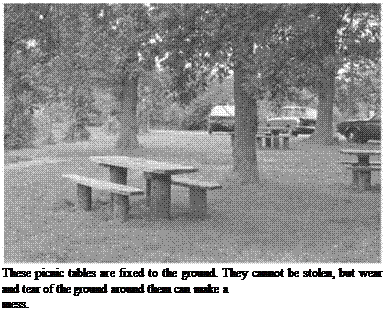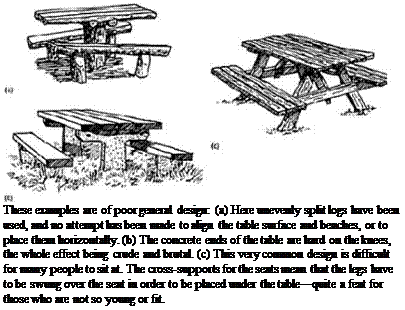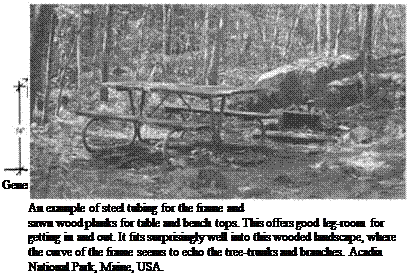Once the area has been laid out to present spaces that are attractive and feel comfortable, any furniture to be provided should be considered. There is a wide variety of picnic furniture of different design and construction to choose from. Many of these are functionally inefficient, ugly and look out of place in the outdoors.
Any furniture should be welcoming and comfortable to use, easy to maintain and able to withstand ill-treatment or theft. There are two basic kinds of table: those fixed to the site and dug into the ground, and those that are movable and placed on top of the ground. The former type are not so easily stolen, and can be of simpler construction, such as separate bench and table pieces placed together. The latter can be stolen, unless anchored in some way or extremely heavy, and they are generally made in one piece. This means that strength and bracing are needed, which can often present problems to the
user.
 |
Sets of fixed tables and benches can be positioned around the site, but any maintenance of the area such as grass cutting has to be carried out around them. Wear and tear of the surface, leading to erosion, puddles and mud, can also occur on busy sites unless the furniture is laid on hard surfacing. It is important to adjust the site to enable the tables and benches to be laid level.
Movable tables and benches allow worn areas to be repaired by shifting the furniture to another place. Their positions can be changed to allow mowers onto the site, or to take advantage of locations of better sunshine, and they can be taken off site into storage during the winter. They often need to be anchored by chain to a buried anchoring device, and sometimes it is difficult to level them.
Table and bench sets should be designed so that anyone and everyone can use them. Benches that require agility to swing legs over cross-members or beams in order to sit at the table, or which do not permit wheelchair use, are badly designed. Also, the surfaces should be smooth and flat. Rough-cut warped boards or round timber are not acceptable. Adequate room to move about on benches is needed without the risk of banging knees on protruding bits of wood or bolt ends. Table
tops should extend lengthways to allow wheelchairs to fit beneath them.
The dimensions of tables and benches are fairly straightforward (see diagram), based on normal dining table and chair sizes, but the depth to which a bench or table is to be set into the ground must be allowed for. Benches that are too low or too high are uncomfortable to use.
 |
Tables and benches should usually be fabricated in sections so that they can be assembled on site, and so that damaged or worn sections can easily be replaced. Maintenance should include tightening of bolts if the structure loosens in very dry weather. Protruding bolts and nuts should be countersunk and trimmed off to prevent snags to clothing or knees.
 |
While tables might be acceptable on the more developed sites near cars, they may look out of place deeper in the wilder landscape. Benches at the side of a trail, slabs of rock, logs sawn in half or in some circumstances more sculptural solutions developed to respond to the character of the setting are alternatives, easier to install and maintain in more remote locations where materials have to be carried in by hand.
Materials that have been used for tables and benches include concrete, steel, plastic and wood. Concrete frames with wooden bench and table tops are sturdy and durable but unyielding on contact, frequently ugly and look urban. Different types of concrete—varied aggregate colour and rough-textured finishes—have been used, but they rarely fit into the landscape. Only when rock is a significant feature of the site and the table supports are simple and of the same colour does concrete fit in at all.



